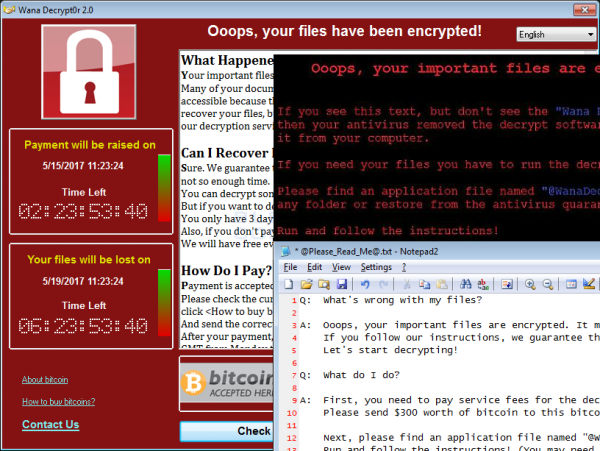Starting with the cellular operator Telefonica in Spain and hospitals in the UK, the extortion virus known as WannaCry already attacked more than 250,000 computers around the world. Most of the attacks were recorded in Russia.

What is WannaCry?
WannaCry or WCry infects only Windows computers. It encrypts user files, changes their extension to .WNCRY, and requires you to buy a special key. You should pay in Bitcoins. According to the latest information, it’s 600 USD, previously reported about 300 USD. Otherwise virus threatens to delete the files. The name WannaCry appears in the name of all infected files. Users only have 3 days to make a payment, after which the price will be doubled, and if they do not pay within 7 days, they will not be able to restore the files.
The malicious program gets distributed by e-mail. The developer of Avast antivirus assumes that the cyber group called The Equation Group created this virus. They used stolen hacking tools earlier developed by the US National Security Agency.
The attack occurs through a known network vulnerability known as MS17-010. Then the rootkit gets installed on the infected system. Using this rootkit, the attackers may start the encryption program.
The first version of the virus WannaCry appeared in February. Now it operates in 28 different languages, from Bulgarian to Vietnamese.
Who is already already infected with WannaCry?
The healthcare system in the UK was completely paralyzed because the virus blocked most files with patients’ data. WannaCry infected at least 25 hospitals. The attack succeeded because computers were not updated on time, although the vulnerability patch was released by Microsoft in March. According to Reuters, employees of the British National Health Service were warned of the threat on Friday, but it was too late.
What to do?
If you have Windows and your computer is not infected yet, you need to install all available updates. Other operating systems are not at risk.
In some cases, paying a ransom for hackers will allow you to unlock files, but it does not always happen. Plenty of users already transferred their money to the creators of the virus.
If your computer is already infected, you can hardly do anything. If you have a backup, you can restore everything after reinstalling the system. If you do not have backups try following our tips below.
Automatic removal of WannaCry ransomware
The benefits of using the automatic security suite to get rid of this infection are obvious: it scans the entire system and detects all potential fragments of the virus, so you are a few mouse clicks away from a complete fix.
- Download and install recommended malware security suite
- Select Start Computer Scan feature and wait until the utility comes up with the scan report. Proceed by clicking on the Fix Threats button, which will trigger a thorough removal process to address all the malware issues compromising your computer and your privacy.
Restore files locked by WannaCry virus
WannaCry virus represents a unique category of malicious software whose attack surface reaches beyond the operating system and its components, which is why removing the virus itself is a part of the fix only. As it has been mentioned, it encrypts one’s personal information, so the next phase of the overall remediation presupposes reinstating the files that will otherwise remain inaccessible.
-
Launch data recovery software
Similarly to the rest of its fellow-infections, WannaCry most likely follows an operational algorithm where it erases the original versions of the victim’s files and actually encrypts their copies. This peculiarity might make your day, because forensics-focused applications like Data Recovery Pro are capable of restoring the information that has been removed. As the virus further evolves, its modus operandi may be altered – in the meanwhile, go ahead and try this.
-
Take advantage of Volume Shadow Copy Service
This technique is based on using the native backup functionality that’s shipped with Windows operating system. Also referred to as Volume Snapshot Service (VSS), this feature makes regular backups of the user’s files and keeps their most recent versions as long as System Restore is on. WannaCry virus hasn’t been found to affect these copies therefore the restoration vector in question is strongly recommended. The two sub-sections below highlight the automatic and manual workflow.
- a) Use Shadow Explorer
Shadow Explorer is an applet that provides an easy way of retrieving previous versions of files and folders. Its pro’s include an intuitive interface where the computer’s entire file hierarchy is displayed within one window. Just pick the hard disk volume, select the object or directory to be restored, right-click on it and choose Export. Follow the app’s prompts to get the job done.

- b) Use file properties
Essentially, what the above-mentioned Shadow Explorer tool does is it automates the process that can otherwise be performed manually via the Properties dialog for individual files. This particular approach is more cumbrous but just as effective as its software-based counterpart, so you can proceed by right-clicking on a specific file, which has been encrypted by WannaCry ransomware, and selecting Properties in the context menu. The tab named Previous Versions is the next thing to click – it displays available versions of the file by date of the snapshot creation. Pick the latest copy and complete the retrieval by following the prompts.

-
Data backups work wonders
Ransomware like WannaCry isn’t nearly as almighty and destructive in case you run regular file backups to the cloud or external data media. The virus itself can be completely removed in a matter of minutes, and the distorted information can then be just as easily recovered from the backup. Luckily, this is a growing trend, so ransom Trojans are hopefully going to become less subversive in the near future.
Verify thoroughness of the removal
Having carried out the instructions above, add a finishing touch to the security procedure by running an additional computer scan to check for residual malware activity
